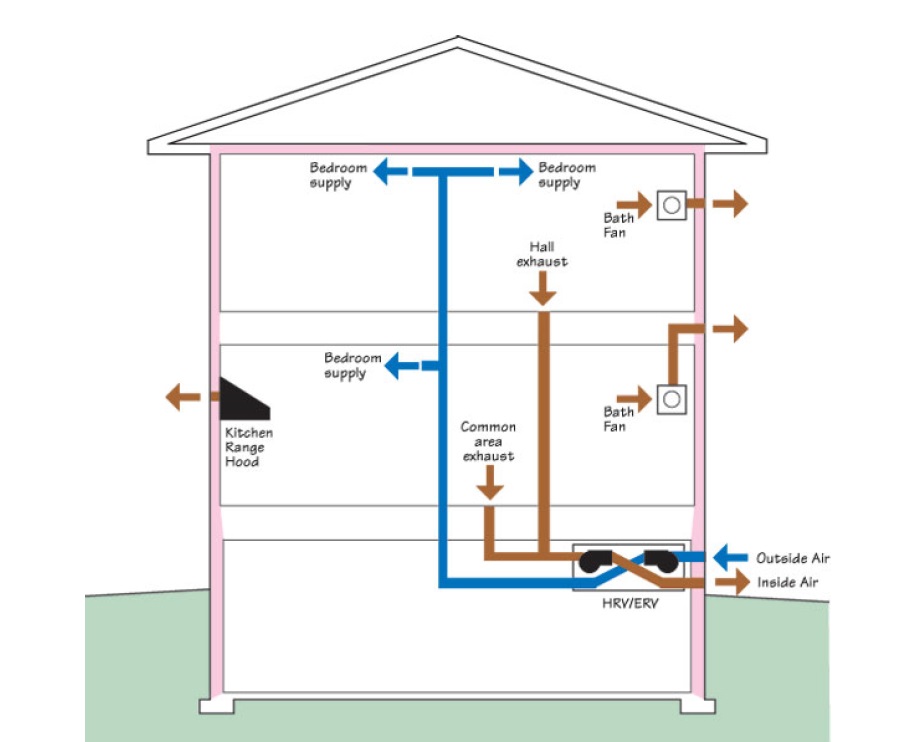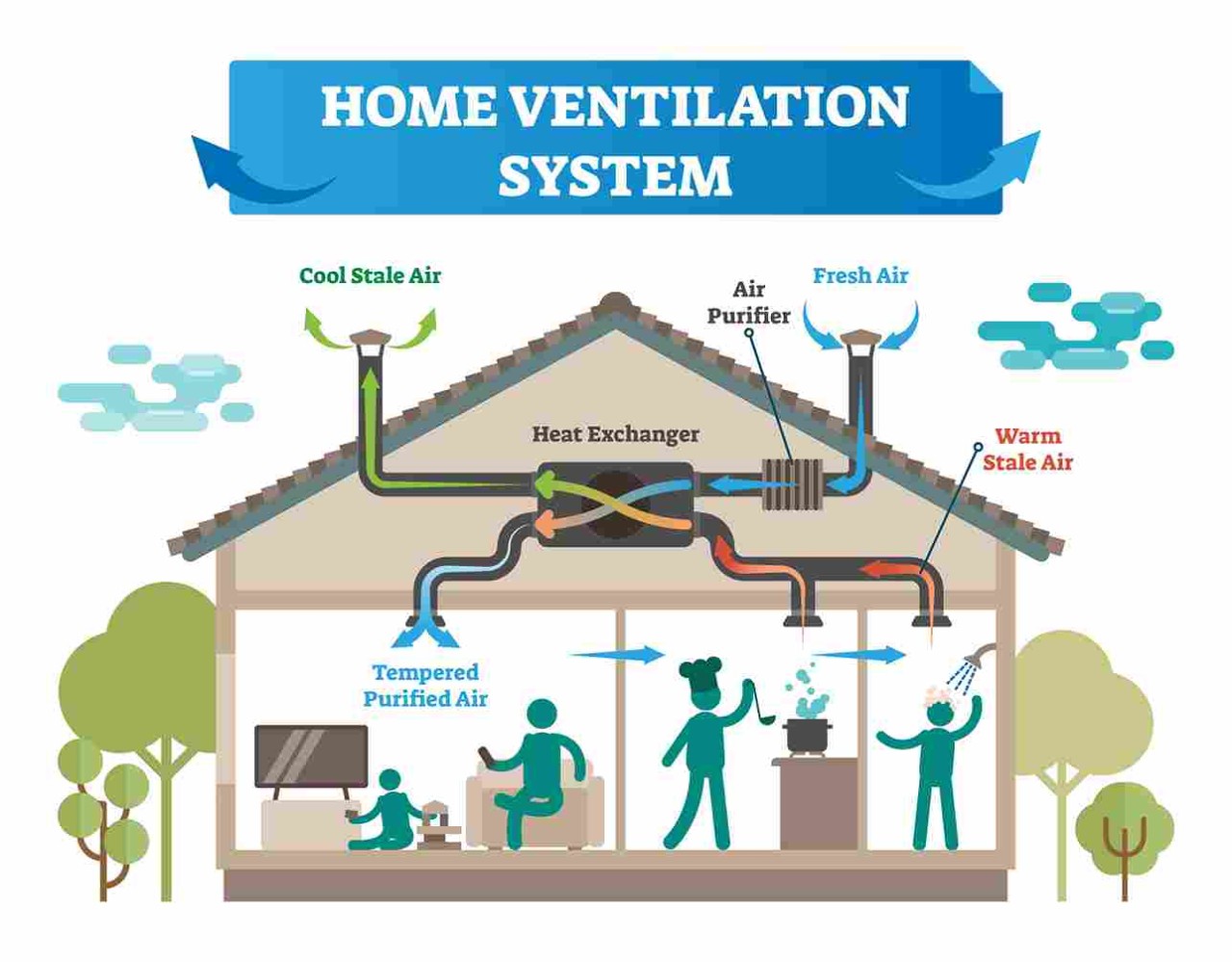Expert Answers to Common Questions About Home Ventilation Melbourne
Wiki Article
Understanding the Value of Home Air Flow for a Healthier Living Atmosphere
Home air flow plays a vital function in keeping a healthy living environment. It facilitates the exchange of indoor and exterior air, which is crucial for enhancing air top quality. Without proper air flow, homes can come to be breeding premises for toxins and irritants. The consequences of insufficient air flow can be considerable. This raises the inquiry of how property owners can properly execute air flow strategies to guard their health and wellness and well-being. Comprehending these techniques is crucial.
The Basics of Home Ventilation
Home ventilation works as an essential part of indoor air top quality and comfort. It includes the process of trading stale indoor air with fresh outside air, thereby minimizing humidity and regulating temperature level. Correct air flow systems can consist of natural techniques, such as open windows and vents, in addition to mechanical systems, such as exhaust followers and air exchangers. Reliable home ventilation helps stop problems like indoor mold development and the buildup of dangerous fragments. It also boosts total energy efficiency, as well-ventilated areas can keep comfy temperatures with less reliance on home heating and cooling down systems. Comprehending the essentials of home air flow is crucial for home owners seeking to create a healthier living atmosphere on their own and their families.
Typical Sources of Indoor Air Air Pollution

Although many may not recognize it, interior air contamination can stem from numerous resources within a family. Common contributors consist of unstable natural substances (VOCs) emitted from paints, solvents, and cleansing products. Family home appliances, such as gas ranges and fire places, can launch unsafe gases like carbon monoxide and nitrogen dioxide. Additionally, mold and mildew and mold flourish in damp locations, releasing spores that affect air quality. Animal dander, dust mites, and pollen can build up inside, additional exacerbating air pollution degrees. Smoking indoors creates poisonous chemicals that stick around airborne. Building materials, including asbestos and formaldehyde, can off-gas damaging compounds. Identifying these sources is essential for preserving a healthier indoor setting and promoting effective air flow strategies.
Wellness Results of Poor Air Flow
Indoor air contamination can have considerable health and wellness ramifications, especially when air flow is insufficient. Poor ventilation can lead to the build-up of unsafe toxins, such as volatile organic substances, mold, and particle matter. This buildup might lead to respiratory issues, including asthma, allergies, and persistent obstructive pulmonary condition. People may experience signs like migraines, exhaustion, and irritability of the eyes, nose, and throat. Vulnerable populations, such as kids and the senior, go to greater danger for extreme wellness results. Long-term exposure to badly ventilated atmospheres can additionally add to much more significant conditions, consisting of heart diseases. As a result, making certain proper air flow is crucial for preserving a healthy living environment and minimizing the risk of health and wellness problems connected with interior air contamination.Reliable Air Flow Approaches for Your Home
Correct air flow is necessary for maintaining a healthy interior atmosphere, and carrying out effective strategies can greatly boost air high quality. Homeowners can begin by guaranteeing that exhaust followers are set up in restrooms and cooking areas to eliminate excess dampness and odors. Opening up home windows routinely enables fresh air to distribute, specifically during light weather condition. Additionally, utilizing air cleansers with HEPA filters can help record airborne my explanation contaminants. For homes with home heating and cooling systems, keeping heating and cooling systems and transforming filters on a regular basis is vital for peak efficiency. Incorporating all-natural air flow techniques, such as cross-ventilation, can also improve airflow. Finally, sealing any leaks in doors and home windows prevents undesirable drafts, which can disrupt controlled air movement, eventually causing boosted interior air quality and comfort.Maintaining Optimal Air High Quality Year-Round
To keep excellent air quality year-round, house owners should adopt a positive technique to handling their indoor atmosphere. Consistently monitoring indoor air quality is important; this includes monitoring for toxins such as dirt, mold and mildew, and unpredictable organic compounds (VOCs) Executing reliable ventilation systems, such as exhaust fans and air purifiers, can significantly decrease airborne contaminants. Additionally, regular maintenance of cooling and heating systems guarantees peak performance and air flow. House owners need to likewise consider humidity levels, as extreme moisture can result in mold growth. Seasonal adjustments may necessitate adjustments in ventilation approaches to fit varying exterior air high quality. By prioritizing these techniques, home owners can produce a healthier space, promoting total health for all passengers throughout the year.Often Asked Questions
Just How Can I Inform if My Home Demands Better Ventilation?
To establish if a home requires better ventilation, one need to observe signs such as relentless moisture, mold growth, musty smells, condensation on home windows, or increased allergic reaction signs, showing inadequate air flow address and possibly poor indoor air quality.What Are the Indicators of Poor Indoor Air High Quality?

Can Houseplants Improve Indoor Air Top Quality Successfully?
The efficiency of houseplants in improving interior air quality is debated. While navigate to this website some researches suggest they can soak up contaminants and create oxygen, their general influence might be marginal compared to correct ventilation and air filtration systems.Exactly how Frequently Should I Change My Air Filters?
The regularity of air filter modifications generally depends upon use and filter type. Usually, it is recommended to change filters every three months, though houses with animals or allergic reactions might call for more regular adjustments for optimal efficiency.Exist Any Details Ventilation Solutions for Allergic Reaction Sufferers?
Numerous air flow systems, such as HEPA-filtered units, successfully reduce allergens airborne. Home Ventilation Melbourne. These systems trap pet dog, dirt, and pollen dander, giving allergy victims with a cleaner, much healthier interior setting while handling air top quality successfully
It assists in the exchange of interior and exterior air, which is crucial for boosting air top quality. Home air flow offers as an essential component of indoor air quality and comfort. It involves the process of trading stagnant interior air with fresh exterior air, therefore lowering moisture and managing temperature level. Interior air contamination can have substantial health and wellness ramifications, especially when ventilation is poor. Correct air flow is necessary for preserving a healthy indoor setting, and applying reliable methods can considerably enhance air high quality.
Report this wiki page